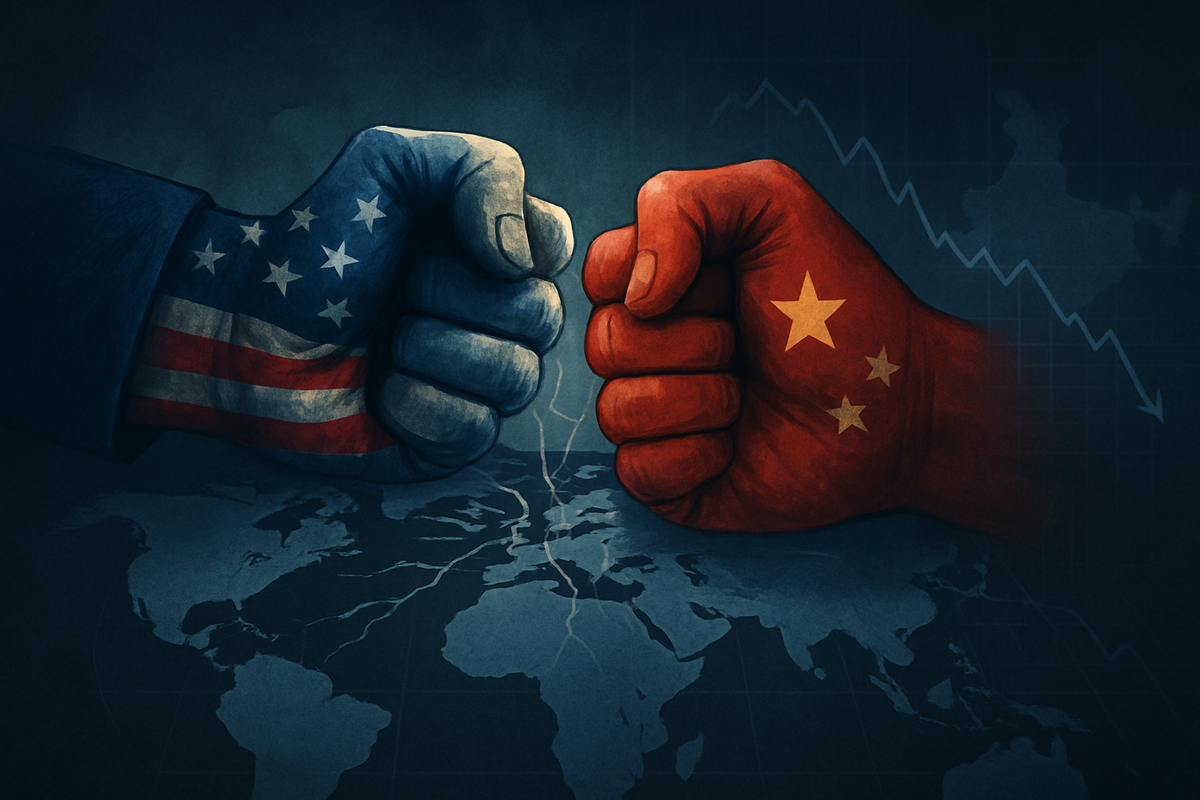
The global financial landscape is once again gripped by uncertainty as trade tensions between the United States and China have re-escalated to a critical juncture in early October 2025. This renewed standoff, marked by aggressive tariff announcements and export controls from both economic giants, has sent ripples across international markets. Locally, the immediate fallout is evident in Gift Nifty's lower trading, signaling a cautious, if not bearish, sentiment that is poised to cast a shadow over the opening of Indian indices.
The sudden intensification of the US-China trade conflict is a stark reminder of the fragile interconnectedness of global economies. As investors grapple with the implications of disrupted supply chains and heightened geopolitical risks, the Indian market finds itself at a pivotal crossroads, navigating both potential opportunities and significant headwinds. The performance of Gift Nifty, often a bellwether for the National Stock Exchange (NSE) Nifty 50 (NSE: NIFTY), underscores the immediate challenge facing Indian equities.
Re-escalation of US-China Trade War Rattles Global Confidence
The current wave of global trade tensions reached a "full boil" around October 10-12, 2025, primarily driven by a renewed trade war between the United States and China. The catalyst for this escalation was China's announcement on October 9 of stricter export controls on rare earth minerals and critical software, vital components for high-tech industries ranging from semiconductors to electric vehicles. Beijing justified these measures citing national security concerns, framing them as a direct response to earlier US restrictions targeting Chinese technology firms. These controls included production technologies, equipment, and specific rare earth elements, alongside new port service fees on US vessels effective October 14, and an antitrust investigation into US chipmaker Qualcomm (NASDAQ: QCOM).
The US was quick to retaliate. President Donald Trump announced an additional 100% tariff on Chinese imports, slated to take effect by November 1, 2025, or potentially sooner. These new tariffs would be layered on top of existing duties, potentially pushing total tariff rates to an staggering 130%. Furthermore, new export controls on critical US-made software were indicated, with President Trump accusing China of "extraordinarily aggressive" and "hostile" actions. This tit-for-tat escalation has severely spooked investor sentiment globally, leading to significant market downturns. The S&P 500 (NYSE: SPX) experienced its worst day since April on October 10, and consequently, Asian markets, including Gift Nifty, reflected this bearish trend by trading lower on October 13, 2025.
The World Trade Organization (WTO) had initially projected a contraction in global merchandise trade for 2025 but later revised its forecast upwards to 2.4% growth due to increased spending on AI-related products and a surge in North American imports anticipating tariff hikes. However, the WTO simultaneously warned that intensified reciprocal tariffs, such as those now being implemented, could cause global merchandise trade to shrink by as much as 1.5% in 2025, with the 2026 forecast significantly lowered to a mere 0.5% growth. This reflects an expected slowdown due to tariffs and a cooling global economy, with Asia's contribution to global trade growth also projected to halve.
Gift Nifty, which serves as a crucial early indicator for the Indian stock market, was observed trading around 25,317 on October 13, 2025, indicating a discount of approximately 93 points from the Nifty futures' previous close. This signals a likely gap-down start for Indian markets. The primary reasons for this lower trading are negative global cues stemming from the US-China trade war re-escalation, sustained outflows by Foreign Institutional Investors (FIIs) who have been net sellers in Indian equities through September and early October 2025, and broader macroeconomic uncertainties. This contrasts sharply with October 9, 2025, when Gift Nifty showed a positive start due to "easing global tension," highlighting its acute sensitivity to daily geopolitical developments.
Indian Market: Navigating Opportunities Amidst Headwinds
The re-escalation of US-China trade tensions presents a mixed bag for the Indian market, creating both potential beneficiaries and those likely to face significant challenges. On the one hand, the steep US tariffs on Chinese goods offer a "hidden positive impact" and "huge export opportunities" for India. As Chinese products become prohibitively expensive, American buyers are expected to actively seek alternative suppliers. This scenario could significantly benefit Indian exporters in labor-intensive sectors such as textiles, toys, and electronics. Given that the US was India's largest trading partner in 2024-25, with Indian exports totaling $86 billion, this shift could translate into substantial gains for companies like Arvind Ltd. (NSE: ARVIND) in textiles or unlisted toy manufacturers looking to expand their global footprint.
Conversely, several sectors and companies could face headwinds. India was already grappling with existing US tariffs, initially 25% and later doubled to 50% in August 2025, due to its continued imports of discounted Russian crude oil. These tariffs particularly impacted labor-intensive Indian industries, which could now face compounded pressure if global demand softens further. Companies reliant on specific rare earth minerals or critical software from China might also experience supply chain disruptions and increased input costs, potentially affecting manufacturers in the electronics or specialized machinery sectors. Furthermore, the sustained outflows by Foreign Institutional Investors (FIIs) in September and October 2025, driven by global uncertainties, are likely to exert downward pressure across various market capitalization segments, impacting a wide array of public companies.
A significant silver lining for India, however, comes from the potential crash in crude oil prices driven by the trade war's impact on global demand. A sustained decline in crude oil prices is highly beneficial for India, a major oil importer. This could lead to lower inflation, a stronger Indian Rupee (INR), and make Indian assets more attractive to foreign capital. Indian oil marketing companies like Indian Oil Corporation Ltd. (NSE: IOC) and Bharat Petroleum Corporation Ltd. (NSE: BPCL) could see improved margins, while sectors with high energy consumption would benefit from reduced operational costs. Despite this, the Indian Rupee remained under pressure in September 2025 and is expected to remain range-bound in October, indicating that the broader global trade tensions and FPI outflows are still significant factors. India's policy response, emphasizing domestic manufacturing through initiatives like the Production-Linked Incentive (PLI) scheme, aims to strengthen local industries and diversify export markets, providing a strategic hedge against geopolitical risks.
Broader Implications: A Shifting Global Trade Order
The re-escalation of the US-China trade war extends beyond immediate market fluctuations, signaling a more profound shift in global trade dynamics. This event fits squarely into broader industry trends of deglobalization and the concerted effort by nations to diversify supply chains and reduce reliance on single manufacturing hubs. The push for "reshoring" or "friendshoring" by developed economies, particularly the US, is gaining momentum, accelerating a technological decoupling between the world's two largest economies. This could lead to a bifurcation of global technology standards and supply chains, forcing companies worldwide to choose sides or develop parallel systems.
The ripple effects on competitors and partners are substantial. Countries heavily integrated into the US-China supply chain, such as Vietnam, Mexico, and even some European nations, could face significant disruption as trade flows are rerouted or curtailed. While some may benefit from trade diversion, others could see reduced demand or increased costs. The WTO's revised forecasts, which warn of a potential 1.5% contraction in global merchandise trade if tariffs intensify, underscore the systemic risk these tensions pose to global economic growth. The forecast for 2026, lowered to just 0.5% growth, paints a grim picture for sustained global expansion.
From a regulatory and policy perspective, this environment necessitates strategic adaptations. India's emphasis on strengthening domestic manufacturing through the Production-Linked Incentive (PLI) scheme across various sectors is a direct response to these geopolitical and trade uncertainties. This policy aims to build resilience and self-reliance, mitigating the impact of external shocks while simultaneously positioning India as an attractive alternative manufacturing base. Diversifying export markets is another critical strategy, reducing India's vulnerability to unilateral trade actions from any single partner. Historically, such trade wars, like the Smoot-Hawley Tariff Act of 1930, have often led to retaliatory measures, a collapse in global trade, and exacerbated economic downturns. While the current situation is different in scope and context, the underlying principle of protectionism sparking global economic contraction remains a potent historical precedent.
The Path Ahead: Volatility and Strategic Realignments
Looking ahead, the short-term outlook for financial markets, particularly those sensitive to global trade like India, suggests continued volatility. The immediate possibility includes further tariff hikes and retaliatory measures from both the US and China, which could deepen the global economic slowdown. Investors should brace for increased market swings, driven by geopolitical headlines and macroeconomic data reflecting the impact of trade disruptions. Companies with significant international exposure or complex supply chains will need to rapidly assess and adapt their strategies to mitigate risks, potentially by diversifying sourcing, adjusting pricing, or re-evaluating market entry strategies.
In the long term, these trade tensions are likely to accelerate the reshaping of global supply chains, fostering increased regional trade blocs and a greater emphasis on national economic security. India stands to gain significantly from this realignment, potentially emerging as a more prominent alternative manufacturing and export hub. The "China Plus One" strategy, where global companies seek to diversify their manufacturing base away from China, could see increased adoption, benefiting Indian companies in sectors ripe for investment and production. This presents strategic pivots for Indian policymakers to attract foreign direct investment and further integrate into new global value chains.
Market opportunities may emerge for sectors that can effectively substitute imports or scale up exports to markets seeking alternatives to Chinese goods. However, challenges include navigating a fragmented global trade landscape, potential protectionist measures from other countries, and the need for significant infrastructure and regulatory reforms to capitalize fully on these opportunities. Potential scenarios range from a prolonged period of trade friction, leading to a more fragmented global economy, to a eventual de-escalation through diplomatic efforts, though the latter appears less likely in the immediate future given the current rhetoric. Investors must therefore remain agile, focusing on companies with strong domestic demand, resilient supply chains, and those poised to benefit from India's strategic positioning in a changing global order.
Concluding Thoughts: Resilience in a Turbulent World
The re-escalation of global trade tensions between the United States and China marks a critical juncture for the world economy and, particularly, for the Indian market. The immediate signal from Gift Nifty trading lower serves as a potent reminder of the interconnectedness of global financial markets and the direct impact of geopolitical events on local indices. While India faces the immediate challenge of navigating negative global cues and sustained FII outflows, the situation also presents unique opportunities for the nation to bolster its manufacturing capabilities and expand its export footprint in a realigned global trade landscape.
Moving forward, the market is expected to remain characterized by elevated volatility and a heightened sensitivity to international trade developments. Investors should focus on companies demonstrating resilience, strong fundamentals, and an ability to adapt to shifting supply chains and market demands. The Indian government's continued focus on domestic manufacturing through schemes like PLI and efforts to diversify export markets will be crucial in mitigating risks and harnessing opportunities.
Key takeaways from this event include the increasing importance of supply chain resilience, the strategic advantage for countries like India that can offer alternative manufacturing bases, and the enduring impact of protectionist policies on global trade growth. What investors should watch for in the coming months are further announcements regarding tariffs, the trajectory of FII flows into and out of Indian equities, movements in crude oil prices, and the effectiveness of India's policy responses in cushioning the economy from external shocks while leveraging new opportunities. The path ahead demands prudence, strategic foresight, and a keen understanding of the evolving global economic order.
This content is intended for informational purposes only and is not financial advice







